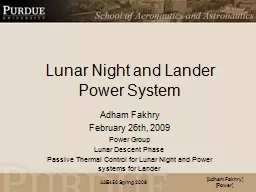

Adham Fakhry February 26th 2009 Power Group Lunar Descent Phase Passive Thermal Control for Lunar Night and Powe r systems for Lander Adham Fakhry Power Power Systems Update Solar Cells ID: 927910
Download Presentation The PPT/PDF document "Lunar Night and Lander Power System" is the property of its rightful owner. Permission is granted to download and print the materials on this web site for personal, non-commercial use only, and to display it on your personal computer provided you do not modify the materials and that you retain all copyright notices contained in the materials. By downloading content from our website, you accept the terms of this agreement.
Slide1
Lunar Night and Lander Power System
Adham FakhryFebruary 26th, 2009Power GroupLunar Descent PhasePassive Thermal Control for Lunar Night and Power systems for Lander
[Adham Fakhry] [Power]
Slide2Power Systems Update
Solar CellsMax. Potential Power = 253 WattsArea = 0.785 m2Cells are extremely thinWeight = 2 kgCost = $235,000 BatteryPower available = 101.6 WattsDimensions = 0.142 m X 0.0534 m X 0.1502 mWeight =
0.64 kg
Cost = $2,000
[Adham Fakhry] [Power]
2
Slide3Lunar Night Thermal Control
Will use HydrazineNeed to decrease the thermal conductivity of the Multi-layered Insulation.Can be accomplished by increasing the number of polished Aluminum Mylar Layers from 1 to 10-15From 0.044 W/m2K4 to 0.000112 W/m2
K
4
and increase MLI thickness to at least
10 mm
In order to allow only 10
W
heat to escape from LanderWith this system, will need 3.45 kg of Hydrazine to heat the Lander for Lunar NightCurrent system will allow 5215.98 Watts to dissipate and will need 1804.19 kg of hydrazine to survive the night
[Adham Fakhry] [Power]
3
Slide4Backup Slide 1 - Battery Specifications
3.6 V, 20 Ah Lithium Ion CellGives 72 W-hr only need 44 W-hrEnergy Density = 140 W-hr/kgDimensions = 0.142 m X 0.0534 m X 0.1502 mCost $2000 per cellFrom Yardney - Lithion
[Adham Fakhry] [Power]
4
Slide5Backup Slide 2 - Battery Design
Battery is designed for meet four power goals:Delivers 100 W for 450 seconds for operating the Lander engineDelivers 35 W for 450 seconds of heating the propellantDelivers 40 W of cooling for 500 seconds (if need be)Delivers 44 W for 30 minutes for all communication gear[Adham Fakhry] [Power]
5
Slide6Backup Slide 3 - Passive Thermal Control
Cost around $24,000 for every kg to the moonIn interest of saving cost, choose Hydrazine instead of hydrogen PeroxideSave $96,000 by using HydrazineNeed 3.5 kg on Hydrazine to heat Lander for 2 weeks of Lunar Night[Adham Fakhry] [Power]
6
Slide7Backup Slide 4 - Heats of Reaction Calculations
10 W 14 days =10W∙14 days∙24 hrs/day.60 min/s.6 secs= 12096000 JoulesHrxn = -112093 J/mol = 3502916 J/KgMass of Hydrazine = 3.45 kg
[Adham Fakhry] [Power]
7
Slide8Backup Slide 5
With 7 mm MLI and K = 0.044 W/m2K4Losing 5215.98 WattsWith Hydrazine providing only 13.5 X 106 Joules, would need 1804.19 kg of hydrazine to keep Lander warmNeed to decrease thermal conductivity of MLI by increasing number of polusihed Aluminum layers
[Adham Fakhry] [Power]
8
Slide9Backup Slide 6
[Adham Fakhry] [Power]9
Slide10Backup Slide 7
[Adham Fakhry] [Power]10
Slide11Backup Slide 8
Using the Effective Emissivity equation and assuming that the ML will have an emittance of 0.005. Thickness of MLI is 10 mm, and the TC is 143 K and TH is 273 K.Thermal conductivity = 0.000112 W/m2K4
Heat lost through Lander by using Heat transfer equation = 9.95 W
Surface area of Lander = 6.054 m
2
[Adham Fakhry] [Power]
<#>
Slide12Backup Slide 9: References
References:http://www.yardney.com/http://nmp.jpl.nasa.govhttp://www.aec-able.com/corpinfo/Resources/ultraflex.pdfhttp://www.spectrolab.com/Spacecraft Thermal Control
Handbook
Transport Phenomena in Materials Processing
Space Propulsion Analysis and Design
[Adham Fakhry] [Power Group]
1`